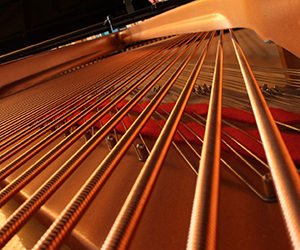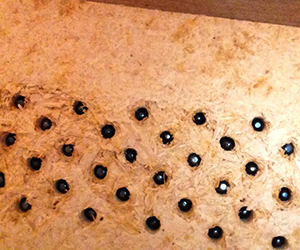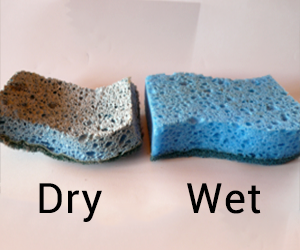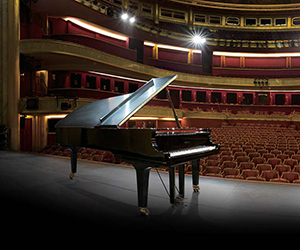When you purchased your last car, you knew you’d have to maintain it. You expected to fill it with gas on a weekly basis; you knew you’d have to wash it from time to time and you planned on an oil change every 3000 miles. You also knew that – as your car aged – it would begin to wear out. Over time, you’d have to put on some new tires; you’d have to replace the brakes and you’d have to swap the battery at some point. From the beginning, you understood that such expenses were necessary to maintain your car’s performance and resale value. Now imagine that your car was made out of wood. How many more repairs and adjustments would you have expected to make?
Like a car, pianos have thousands of tiny components – many of which move or vibrate as part of their vital function. …and, like neglected cars, neglected pianos will deteriorate to a point where they can’t be used (or sold) without costly repairs. Put simply, it’s much less expensive to properly maintain your piano than to allow it to fall into disrepair. Why, then, do so many piano owners neglect their instruments?
Oddly enough, most people don’t understand why pianos require regular maintenance. It’s fairly easy for car owners envision the “wear and tear” their breaks or tires experience, but piano “wear and tear” is often much more subtle.
New Pianos

A piano’s strings are under ALOT of pressure – up to THREE ELEPHANTS worth of tension!
New piano builders tighten each of the 230-some strings to a strain of nearly 200lbs each. This means that the wood frame (reinforced with a cast-iron plate) is holding back a pressure of over 20 tons – that’s as much weight as about three and a half elephants!
Due to this extreme pressure, new pianos go through a period of adjustment or “breaking in” during their first two years of life. Most notably, their wood components will adjust to the room climate, the piano’s strings will stretch significantly and the hitch pins (which hold the strings at the back) will develop grooves that prevent the strings from slipping around them. By the end of the second year, most pianos will have settled into their proper tuning tension. At this point, they will become much more stable and require less frequent tuning.
Piano Construction

Cheap pianos are often made with composite materials like particleboard and plastic. These materials do not hold up well over time.
As cheap import pianos flood the market with composite parts and low-grade woods, more and more piano owners are rediscovering the “buy nice or buy twice” principle. While a “starter” piano might seem attractive because of its lower price, its particleboard and plastic construction won’t be able to withstand the 20-ton strain as well as an instrument made with top-grade components. The piano will pull itself out of tune more frequently – thus making up for its lower purchase price with excessive long-term maintenance costs.
Piano Placement
Even the best pianos will struggle with tuning stability, however, if they are poorly placed.

Unlike us, pianos don’t want to be “warm and cozy” by the fire. Vents, fire places, strong sunlight – can all dry out a piano quickly – pulling it out of tune and shortening its lifespan.
It’s never a good idea to position a piano in the path of direct sunlight, near an air vent, against an un-insulated outside wall or close to fixtures that directly affect a room’s temperature or humidity (such as a fire place, electric heater or fish tank). These conditions create additional stresses on the piano and will push it out of tune quickly.
Environmental Changes
85% of the piano is made from wood – a porous material that is susceptible to changes in temperature and humidity. During periods of increased humidity, the piano’s wood components absorb moisture and expand – pushing against the strings and forcing the piano out of tune. As the humidity lessens, the wood dries out and shrinks – loosening the string pressure and pulling the piano out of tune. Though these changes occur on a daily basis, major seasonal changes can cause significant variations in a piano’s pitch. This is why most manufacturers recommend a minimal bi-annual tuning schedule.

What happens to a sponge when it dries out? What happens when a sponge gets wet? The same things happen to pianos…
Poor Tuning Technique
Of course, no matter how often a piano is tuned, no piano will remain in tune if it was improperly serviced in the first place. A skilled technician will make sure that each string slides equally along its friction points during the adjustment process. This prevents the wire from getting “hung up” and slipping out of tune later. Inexperienced tuners can tighten or loosen a string much more drastically than necessary as they struggle to reach the desired pitch. This makes achieving an equalized pressure across the string nearly impossible. Thus, during play, the string will “shake loose,” equalize its tension and fall out of tune. Tuning pins can also twist or bind during tuning. A skilled tuner will take the time to “set” the pin and make sure it’s stable. This prevents the pin from correcting itself later and pulling the string out of tune. It is always better – and cheaper in the long run – to pay a few dollars more for the services of a skilled technician.
Neglect
Even the best technicians can’t rewrite the laws of physics, however. Variations in the piano’s environment will slowly and subtly pull it out of tune. Whether it’s played regularly or not, every piano requires a minimum annual tuning. A neglected piano will have fallen so far out of tune that it will require a “Pitch Raise” prior to tuning. A “Pitch Raise” restores the proper string tension so the piano can be fine-tuned. A piano that has been neglected for more than a couple of years may require several tunings before it becomes stable at the correct pitch. If neglected for a long period of time (the actual number of years varies by quality), the piano may lose its ability to be tuned. At this point, a good technician will recommend replacing the instrument (as restoration is far too expensive a process for most of these pianos).
Heavy Use

Concert pianos, school or church pianos and any other pianos that are used heavily will require more frequent tuning.
Pianos are percussion instruments and even tuning once or twice a year can sometimes constitute “neglect” if an instrument is used heavily or in a very unstable environment. Pianos used on the concert stage, in universities, in churches or in teaching studios will require four or more tunings per year. This is also true of player pianos that are used heavily. Every time the piano’s hammers impact the strings they increase the tuning stresses on the pins and the strings themselves. This is why it’s so important to play new pianos regularly. This process can help work the “stretch” out of new piano strings. Over time, it will also push a piano out of tune. The more heavily a piano is played (especially if the piano is used for ear-training, performance, recording or play-a-long music) the more quickly it will fall out of tune.
Advanced Age
As people age, their bones become more brittle, their eyesight fades, muscles weaken and their bodies cease to function properly. Pianos age too. Over time, the wood frame will weaken, the curve (or “crown”) of the soundboard will flatten, the tuning pin block will shrink and the metal will fatigue. Once these things begin to happen, the piano will finally lose its life-long battle against the 20-ton string tension. This will happen slowly over a period of several years until a skilled technician recommends replacement.

Even professional piano technicians use tools to “calibrate” their ears. Not all out of tune pianos sound “out of tune.”
Very few people can actually tell whether or not their piano is in tune just by playing it. The process of falling out of tune is so slow and subtle, it’s hard to detect. The only way to make sure a piano holds its tune is to setup a regular maintenance schedule with a local (skilled) technician. Understanding why a piano goes out of tune is just the first step.






Greetings, James! I don’t know if you are still responding to questions, but I thought I would send one to find out. I have a Baldwin BP-148 petite baby grand with a Piano Disc Quietime installed. Can you tell me the ideal humidity and temperature for this piano?
Also, you mention a skilled piano tuner. What kind of credentials does that imply?
Thank you very much for your time.
Hi, Rosemarie! Thanks for stopping by. Yep! We’re still answering questions! Hahaha. The ideal temperature and humidity for your piano fall into your comfort zone. With temperature, the key is stability. If you are comfortable, your piano will be too… just avoid big changes and try to keep the temperature as stable as possible. With humidity, the ideal is 40-60%. This is really hard to do in the winter, but keeping your piano close to that range will help it stay in tune longer and will prolong the life of the piano. Again, the biggest thing is to maintain as much stability as possible. If the room is at 30%, but STAYS at 30% all the time, that can work as well. Pianos are like dogs. They love consistency and routine! hahaha Hope that helps!